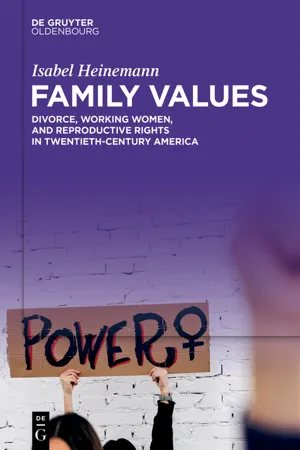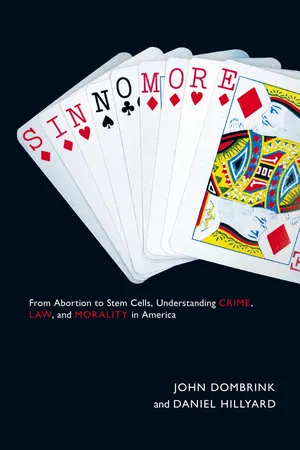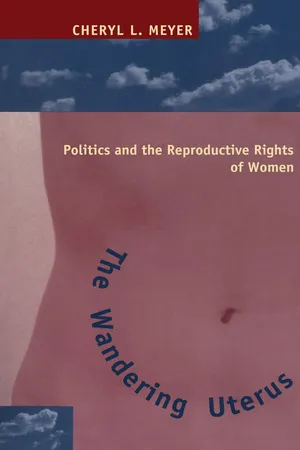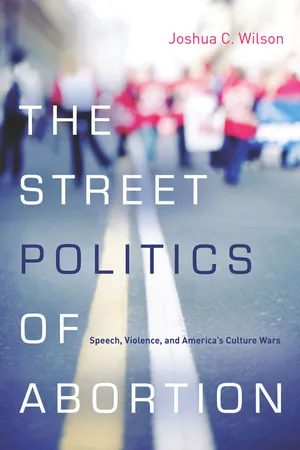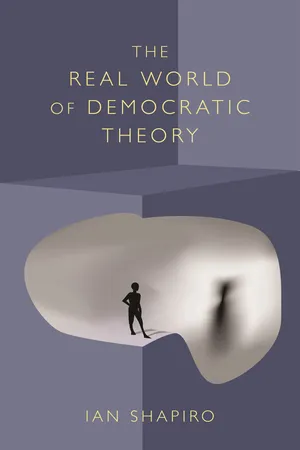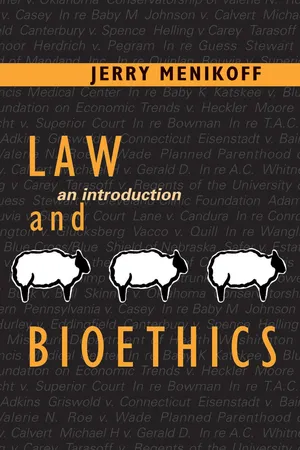Politics & International Relations
Roe v. Wade
"Roe v. Wade" is a landmark 1973 U.S. Supreme Court case that legalized a woman's right to have an abortion. The ruling established a woman's right to choose to terminate a pregnancy within certain restrictions, based on the constitutional right to privacy. This decision has had a significant impact on reproductive rights and has been a highly debated and controversial issue in American politics.
Written by Perlego with AI-assistance
Related key terms
7 Key excerpts on "Roe v. Wade"
- eBook - ePub
Family Values
Divorce, Working Women, and Reproductive Rights in Twentieth-Century America
- Isabel Heinemann, Alex Skinner, Alex Skinner(Authors)
- 2023(Publication Date)
- De Gruyter Oldenbourg(Publisher)
103 The Washington Post, on the other hand, published a critical article that addressed the value conflicts within the Catholic Church, commenting on them from a feminist perspective.104 It was in fact to be quite some time before feminists explicitly defended the law in the press, though the focus of their articles and op-eds was mainly on newly established abortion clinics.105Recent scholarship, however, has not only characterized the Supreme Court’s decision in Roe v. Wade as a liberal achievement, but has also pointed to its era-specific downsides. While Johanna Schoen describes Roe as a positive sign of the inclusion of legal abortion in women’s health care, Mary Ziegler views the decision as the beginning of a long process of reorienting the women’s movement toward “choice” as a form of “single-issue politics.”106 In contrast, Marc Stein criticizes the judges for pursuing a “classed, gendered, and racialized doctrine of heteronormative supremacy.”107 Roe, he contends, was aimed less at women’s reproductive autonomy than at their role in family, marriage, and society. Yet here Stein disregards the fact that in 1973 marriage and family still constituted the national normative lodestone of both politics and jurisprudence. Still, his observations highlight a fundamental problem in the women’s movement’s campaign for the right to abortion: for white activists, the practice had a quite different—exclusively positive—quality than for their African American or Mexican-born comrades-in-arms, who first had to struggle to achieve the right to reproduction itself.108 Stein also points out that although the Supreme Court justices based their decision on the “right to privacy,” they placed the final decision on abortion in the hands of the doctor.109 Detailing future abortion procedures in the first trimester of a pregnancy, the court stated: “the abortion decision and its effectuation must be left to the pregnant woman’s attending physician.”110 - eBook - ePub
Sin No More
From Abortion to Stem Cells, Understanding Crime, Law, and Morality in America
- John Dombrink, Daniel Hillyard(Authors)
- 2007(Publication Date)
- NYU Press(Publisher)
Roe v. Wade .As Ginsburg and Risen and Thomas47 describe, the emergence of direct-action groups such as Operation Rescue brought greater contestation to the abortion issue, one the Christian Coalition built upon as a key organizing issue,48 thus bringing American fundamentalist religious groups to a new prominence in American politics.49With the Supreme Court decision in Planned Parenthood v. Casey in 1992, and the election of Bill Clinton in 1992 and the retirement of an anti-Roe vote on the Supreme Court in the person of Byron White, America reached a period of stability regarding regulation of abortion.50 The pro-life movements splintered into more violent factions and turned their attention toward rebuilding.51 While federal abortion protections reached a plateau, and state constitutional protections increased access to abortion, the contestation of “partial-birth” late-term abortions eventually emerged and by 2004 reshaped an issue that threw traditional political strategy into disarray.Culture Warriors in 2004
Abortion was a strong theme in the 2004 presidential election, when Massachusetts senator John Kerry, a pro-choice Catholic, was the Democratic nominee. Bishops in several American Catholic dioceses spoke of their opposition and began a debate over the proper role of the church and politics in this discussion. Some conservative bishops declared that they would not provide Communion or other church sacraments to Kerry or any other pro-choice politician. An extreme position along this line was taken by those bishops who claimed that they would deny the same sacraments to parishioners who supported such candidates. The bishop of Green Bay admonished parishioners, “Don’t leave religion outside the polling booth” when voting in November. - eBook - ePub
The Wandering Uterus
Politics and the Reproductive Rights of Women
- Cheryl L. Meyer(Author)
- 1997(Publication Date)
- NYU Press(Publisher)
[5]Politics and Reproductive Choice
Each state or federal election, every nomination to the Supreme Court, reminds Americans of the pivotal role that women’s reproductive rights play in politics. In elections, some individuals vote solely on a candidate’s stance regarding reproductive choice, that is, regarding abortion. Similarly, the selection and confirmation of Supreme Court justices has frequently turned on the nominee’s interpretation of and opinions about Roe v. Wade. One appointment could disrupt the balance of the Supreme Court and affect the status of Roe v. Wade and the reproductive options of generations of women.For most antichoice individuals, the “unborn” are human beings and have the same rights as all other citizens. Believing that there is no one to speak for the rights of the unborn, the prolifers attempt to speak for them. For prochoice individuals, the issue is often more equivocal. Consider the following example.Mary and John have a newborn infant who was born with a serious liver defect. The baby will die if she does not receive a transplant within the next few days. Mary is not a compatible donor but John is. No other compatible donors are available. Doctors are sometimes able to transplant a portion of a liver, but there is no guarantee of success, and the operation also carries serious risks for the donor, including infection, hemorrhage, diminished liver capacity, and complications (sometimes fatal ones) from anesthesia. John is conflicted. He was never committed to having this baby in the first place. He perceives the risks to his own life to be significant, and he is philosophically opposed to surgery. Clearly John faces a tough choice, but it is his - eBook - ePub
The Street Politics of Abortion
Speech, Violence, and America's Culture Wars
- Joshua C. Wilson(Author)
- 2013(Publication Date)
- Stanford Law Books(Publisher)
1 Abortion Politics, Legal Power, and StorytellingWhen the United States Supreme Court decided the case of Roe v. Wade in January 1973, it simultaneously struck down state abortion laws and helped fuel the creation of the modern social conservative movement. Up through the early 1970s the legality of abortion was largely seen as a “Catholic issue.” That changed in the aftermath of Roe v. Wade .1 While it did not happen immediately, legalized abortion became a central issue for social conservatives who came to see Roe as a particularly morally intolerable example of the political Left once again marshaling the unelected federal judiciary to undo the popular will of the states.2In this line of conservative thinking, the Supreme Court, headed by Chief Justice Earl Warren, was seen as forcing racial integration, banning prayer and religion from public life, creating soft-on-crime policies, and liberating sexual taboos.3 This growing catalog of offenses helped bring Nixon’s “Forgotten Americans” to the polls in 1968, but even that was apparently not enough to stop the Court’s socially disruptive progressive trend. Nixon was almost immediately able to reform the Supreme Court in his first term with four judicial appointments, including Chief Justice, but the Court persisted in producing progressive rulings. Over two decades of controversial court cases and social turmoil had helped to move the Forgotten Americans and the “Silent Majority” to vote, but Roe v. Wade was the ruling that would mobilize a more sustained and not-so-silent movement.The anti-abortion movement has taken many forms in the four decades since.4 In the 1980s and 90s one of its identifying hallmarks was clinic-front activism. These protests took various forms, but collectively they served to publicize the cause, gain more members, give participants the feeling of empowerment via direct action, impede clinic access, and tax clinic resources. A less desirable outcome, from the anti-abortion perspective, was that this activism also spurred abortion-rights advocates to organize to directly counter these street-level tactics. While those fighting for abortion rights may have believed that they had reached their goal with the Roe decision, it quickly became clear that the Supreme Court case was just one step in a protracted and ongoing movement-counter-movement struggle.5 - eBook - ePub
- Ian Shapiro(Author)
- 2010(Publication Date)
- Princeton University Press(Publisher)
Government policies to limit birthrates through abortion and family planning are seen by some as enlightened and necessary; for others they amount to wanton interference with inviolable human rights. Strongly held convictions that women are entitled to sovereign control of their bodies collide with equally resolute beliefs that pregnancy brings with it the responsibility—however unwelcome—to carry a fetus to term. Even murder has seemed justified in the eyes of some in order to prevent the performance of an abortion. “No judicial decision in our time,” writes Ronald Dworkin of the Supreme Court's 1973 decision in Roe v. Wade, which established that women have a constitutionally protected right to abortion, “has aroused as much sustained public outrage, emotion, and physical violence, or as much intemperate professional criticism.” 2 Alasdair MacIntyre goes further, remarking that the most striking feature of the modern abortion debate is its interminable character. The views that are pitted against one another are “conceptually incommensurable” in that although they are internally consistent, they rest on rival premises which “are such that we possess no rational way of weighing the claims of one as against the other.” 3 The ambivalence and conflicting emotions that people feel about abortion were well reflected in a 1989 Los Angeles Times national opinion poll. It reported that although 61 percent of Americans think abortion is morally wrong and 57 percent think it is murder, 74 percent nonetheless believe that “abortion is a decision that has to be made by every woman for herself.” 4 This inconsistency might reflect the reality that abortion is less important to most voters than it is to the activists who join battle over the issue. Perhaps people worry less about resolving conflicting impulses on matters that are less important to them than on matters that are more important - Mary Ziegler(Author)
- 2022(Publication Date)
- Routledge(Publisher)
Roe v. WadeDOI: 10.4324/9781003215936-6In January 1973, Harry Blackmun delivered an opinion in Roe v. Wade [Doc. 10] that would become one of the most notorious in US constitutional law. Richard Nixon had recently nominated both Blackmun and his childhood friend, Warren Burger, to the Court. Nixon presented the two as conservatives concerned with law and order; the two were so similar that commentators called them the “Minnesota Twins.” But in the winter of 1973, Blackmun wrote one of the Supreme Court decisions many would most associate with the liberal federal judiciary.Over the last summer, Blackmun had spent time researching abortion at the library of the Mayo Clinic, an elite medical facility in his native Minnesota. This medical research shaped the Roe decision. Blackmun began by noting how profoundly divisive the abortion issue had already become. In a seven-to-two majority opinion, Blackmun mentioned everything from racism to population control to religion in surveying the roots of the nation’s abortion conflict. Nevertheless, he hoped that Roe would help to lead the nation out of this dilemma. If the Court resolved the abortion issue “by constitutional measurement, free of emotion and of predilection,” then perhaps the conflict might not be as intense.The Court began by addressing whether anyone had the right to challenge Texas’s law in the first place. Norma McCorvey (the real name of Jane Roe) had already given birth by the time the case arrived at the High Court. Arguably, there was no need to resolve the case anymore. Other plaintiffs similarly might have lacked standing to bring a case. But the Court concluded that McCorvey’s suit was not moot; the constitutional questions raised in Roe would not go away simply because Norma McCorvey was no longer pregnant: other people would inevitably seek out abortions, possibly including McCorvey herself.Blackmun turned next to a medical history of abortion. He recognized that the Hippocratic Oath, a vow taken by doctors, seemed to treat abortions as nonethical. Nevertheless, Roe- eBook - ePub
Law and Bioethics
An Introduction
- Jerry Menikoff(Author)
- 2002(Publication Date)
- Georgetown University Press(Publisher)
Roe v. Wade. It is a rule of law and a component of liberty we cannot renounce.On the other side of the equation is the interest of the State in the protection of potential life. The Roe Court recognized the State’s “important and legitimate interest in protecting the potentiality of human life.” The weight to be given this state interest, not the strength of the woman’s interest, was the difficult question faced in Roe. We do not need to say whether each of us, had we been Members of the Court when the valuation of the state interest came before it as an original matter, would have concluded, as the Roe Court did, that its weight is insufficient to justify a ban on abortions prior to viability even when it is subject to certain exceptions. The matter is not before us in the first instance, and coming as it does after nearly 20 years of litigation in Roe’s wake we are satisfied that the immediate question is not the soundness of Roe’s resolution of the issue, but the precedential force that must be accorded to its holding. And we have concluded that the essential holding of Roe should be reaffirmed.Yet it must be remembered that Roe v. Wade speaks with clarity in establishing not only the woman’s liberty but also the State’s “important and legitimate interest in potential life.” That portion of the decision in Roe has been given too little acknowledgment and implementation by the Court in its subsequent cases. Those cases decided that any regulation touching upon the abortion decision must survive strict scrutiny, to be sustained only if drawn in narrow terms to further a compelling state interest. Not all of the cases decided under that formulation can be reconciled with the holding in Roe itself that the State has legitimate interests in the health of the woman and in protecting the potential life within her. In resolving this tension, we choose to rely upon Roe , as against the later cases.Roe established a trimester framework to govern abortion regulations. Under this elaborate but rigid construct, almost no regulation at all is permitted during the first trimester of pregnancy; regulations designed to protect the woman’s health, but not to further the State’s interest in potential life, are permitted during the second trimester; and during the third trimester, when the fetus is viable, prohibitions are permitted provided the life or health of the mother is not at stake. Most of our cases since Roe
Index pages curate the most relevant extracts from our library of academic textbooks. They’ve been created using an in-house natural language model (NLM), each adding context and meaning to key research topics.
